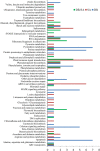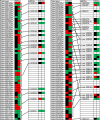Combined analysis of mRNA and miRNA identifies dehydration and salinity responsive key molecular players in citrus roots
- PMID: 28165059
- PMCID: PMC5292693
- DOI: 10.1038/srep42094
Combined analysis of mRNA and miRNA identifies dehydration and salinity responsive key molecular players in citrus roots
Abstract
Citrus is one of the most economically important fruit crops around world. Drought and salinity stresses adversely affected its productivity and fruit quality. However, the genetic regulatory networks and signaling pathways involved in drought and salinity remain to be elucidated. With RNA-seq and sRNA-seq, an integrative analysis of miRNA and mRNA expression profiling and their regulatory networks were conducted using citrus roots subjected to dehydration and salt treatment. Differentially expressed (DE) mRNA and miRNA profiles were obtained according to fold change analysis and the relationships between miRNAs and target mRNAs were found to be coherent and incoherent in the regulatory networks. GO enrichment analysis revealed that some crucial biological processes related to signal transduction (e.g. 'MAPK cascade'), hormone-mediated signaling pathways (e.g. abscisic acid- activated signaling pathway'), reactive oxygen species (ROS) metabolic process (e.g. 'hydrogen peroxide catabolic process') and transcription factors (e.g., 'MYB, ZFP and bZIP') were involved in dehydration and/or salt treatment. The molecular players in response to dehydration and salt treatment were partially overlapping. Quantitative reverse transcriptase-polymerase chain reaction (qRT-PCR) analysis further confirmed the results from RNA-seq and sRNA-seq analysis. This study provides new insights into the molecular mechanisms how citrus roots respond to dehydration and salt treatment.
Conflict of interest statement
The authors declare no competing financial interests.
Figures







Similar articles
-
Integrated RNA-Seq and sRNA-Seq Analysis Identifies Chilling and Freezing Responsive Key Molecular Players and Pathways in Tea Plant (Camellia sinensis).PLoS One. 2015 Apr 22;10(4):e0125031. doi: 10.1371/journal.pone.0125031. eCollection 2015. PLoS One. 2015. PMID: 25901577 Free PMC article.
-
Effect of salt-stress on gene expression in citrus roots revealed by RNA-seq.Funct Integr Genomics. 2018 Mar;18(2):155-173. doi: 10.1007/s10142-017-0582-8. Epub 2017 Dec 20. Funct Integr Genomics. 2018. PMID: 29264749
-
Tetraploid Rangpur lime rootstock increases drought tolerance via enhanced constitutive root abscisic acid production.Plant Cell Environ. 2013 Apr;36(4):856-68. doi: 10.1111/pce.12021. Epub 2012 Nov 8. Plant Cell Environ. 2013. PMID: 23050986
-
Drought, salt, and temperature stress-induced metabolic rearrangements and regulatory networks.J Exp Bot. 2012 Feb;63(4):1593-608. doi: 10.1093/jxb/err460. Epub 2012 Jan 30. J Exp Bot. 2012. PMID: 22291134 Free PMC article. Review.
-
Citrus Plants: A Model System for Unlocking the Secrets of NO and ROS-Inspired Priming Against Salinity and Drought.Front Plant Sci. 2016 Feb 26;7:229. doi: 10.3389/fpls.2016.00229. eCollection 2016. Front Plant Sci. 2016. PMID: 26955378 Free PMC article. Review.
Cited by
-
Sensing of Abiotic Stress and Ionic Stress Responses in Plants.Int J Mol Sci. 2018 Oct 24;19(11):3298. doi: 10.3390/ijms19113298. Int J Mol Sci. 2018. PMID: 30352959 Free PMC article. Review.
-
Expression of a Grape VqSTS36-Increased Resistance to Powdery Mildew and Osmotic Stress in Arabidopsis but Enhanced Susceptibility to Botrytis cinerea in Arabidopsis and Tomato.Int J Mol Sci. 2018 Sep 30;19(10):2985. doi: 10.3390/ijms19102985. Int J Mol Sci. 2018. PMID: 30274342 Free PMC article.
-
Fast Regulation of Hormone Metabolism Contributes to Salt Tolerance in Rice (Oryzasativa spp. Japonica, L.) by Inducing Specific Morpho-Physiological Responses.Plants (Basel). 2018 Sep 15;7(3):75. doi: 10.3390/plants7030075. Plants (Basel). 2018. PMID: 30223560 Free PMC article.
-
miR-363-3p is activated by MYB and regulates osteoporosis pathogenesis via PTEN/PI3K/AKT signaling pathway.In Vitro Cell Dev Biol Anim. 2019 May;55(5):376-386. doi: 10.1007/s11626-019-00344-5. Epub 2019 Apr 25. In Vitro Cell Dev Biol Anim. 2019. PMID: 31025251
-
Integrative analysis of microRNAs and mRNAs reveals the regulatory networks of triterpenoid saponin metabolism in Soapberry (Sapindus mukorossi Gaertn.).Front Plant Sci. 2023 Jan 9;13:1037784. doi: 10.3389/fpls.2022.1037784. eCollection 2022. Front Plant Sci. 2023. PMID: 36699854 Free PMC article.
References
-
- Yang X. Y. et al.. Isolation of a citrus ethylene-responsive element binding factor gene and its expression in response to abiotic stress, girdling and shading. Sci Hortic 127, 275–281 (2011).
-
- Wang M., Wang Q. & Zhang B. Response of miRNAs and their tartgets to salt and drought stresses in cotton (Gossypium hirsutum L.). Gene 530, 26–32 (2013). - PubMed
-
- Bartel D. P. MicroRNAs: genomics, biogenesis, mechanism, and function. Cell 116, 281–297 (2004). - PubMed
Publication types
MeSH terms
Substances
LinkOut - more resources
Full Text Sources
Other Literature Sources

